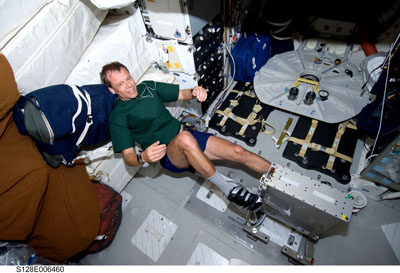ESA astronaut Christer Fuglesang, who is also head of Science & Applications Division in ESA's Human Spaceflight & Operation Directorate, pictured floating near the International Space Station
How do you help astronauts deal with accelerated ageing and a lack of exercise in space? Well, these are the focus of two European Space Agency research contracts, worth €135,000, that have been won by two Irish research scientists.
The European Space Agency (ESA) has awarded the contracts totalling €135,000 to Dr Dónal O’Gorman at Dublin City University (DCU)and Dr Brian Caulfield at UCD.
The awarding of the contracts arises directly from Ireland’s membership of ESA and its space programme. Ireland’s membership of ESA is funded by the Irish Government and is managed by Enterprise Ireland.
Ireland’s Innovation Minister Sean Sherlock said the contracts awarded to the researchers is further evidence of the leading role Ireland plays in pushing the boundaries of biomedical research for the European Human Spaceflight programme.
“We are seeing a growing number of Irish companies developing biomedical technologies with ESA support, which contributes to employment generation in Ireland and which can also benefit society here on Earth. The ESA space-related research in Ireland builds on the strategic investments that the Government has made in life sciences in the past decade through Enterprise Ireland and Science Foundation Ireland.”
Dr Bryan Rodgers from Enterprise Ireland explained why this research is so important.
“Astronauts can be in space for up to 18 months on missions to Mars and onboard the International Space Station, and so they have to adapt to the specific challenges of life in space, such as the absence of gravity, high levels of radiation and cramped living conditions, which often result in deterioration of the astronauts’ hearts, muscles and bone conditions.
“The research of O’Gorman and Caulfield will address these issues and find solutions to enable astronauts to function healthily on critical missions. This research also has applications in the healthcare markets on Earth, as the characteristics of natural human ageing are similar to those experienced by astronauts.”

ESA astronaut Christer Fuglesang, exercising in the International Space Station (ISS). Fuglesang has been on two space missions. He gave a talk at Belvedere College in Dublin last night about space and ISS research
During his visit to Ireland this week, ESA astronaut Christer Fuglesang, who is also head of Science & Applications Division in ESA’s Human Spaceflight & Operation Directorate, welcomed the announcement.
“Keeping in shape is always important, but working out in space is even more crucial in order to counteract the detrimental effects of weightlessness. We still have a lot to learn about how the body reacts in space and find the best methods to keep astronauts fit, also when returning to Earth. I’m very pleased that researchers in Ireland are actively participating in this important field, which eventually will help us to send humans all the way to Mars,” said Fuglesang.
O’Gorman is the director of the Centre for Preventive Medicine at DCU. He will use the ESA funding to investigate novel ways to prevent the negative impact of micro-gravity on the body.
One of the challenges faced by astronauts is that the body seems to go through a process of accelerated ageing while in space. Astronauts who have been to the International Space Station lose muscle and bone mass, while they also begin to develop risk factors more commonly associated with older people. O’Gorman is leading an ESA team to identify biomarkers to track these changes and is investigating if artificial gravity or nutritional modifications can prevent the negative consequences.
The best way to simulate microgravity on Earth is to get people to lie in bed between 21-60 days. O’Gorman will simulate the effect of artificial gravity using a specialist human centrifuge in Toulouse.
In a separate study, he will be investigating the impact of a nutritional countermeasure (whey protein and a salt) on changes in metabolism and skeletal muscle mass. Both studies will help astronauts who go to space, but also have implications for healthcare on Earth, especially for the ageing process.
Caulfield is the director of Technology Research for Independent Living Centre and principal investigator in CLARITY Centre at UCD. He is leading the testing of this novel Neuromuscular Electrical Muscle Stimulation Exercise technology on a parabolic flight campaign in Bordeaux, France.
The technology, developed by Galway-based Biomedical Research, suppliers of electrical muscle stimulation devices for the commercial market, works by stimulating the large muscles of the legs. The parabolic flight campaign provides an opportunity to test this technology in a zero-gravity environment, similar to that experienced on the International Space Station.
The ESA funding is provided through two programmes – ELIPS (European programme for life and physical sciences in space) and PRODEX (Programme de dévelopement d’expériences scientifiques). Enterprise Ireland manages Ireland’s membership of the European Space Agency, which allows Irish researchers to access microgravity test services.
In advance of Dublin City of Science 2012, Siliconrepublic.com is hosting Science November, a month dedicated to news, reports, interviews and videos covering a range of Irish science, research and innovation.